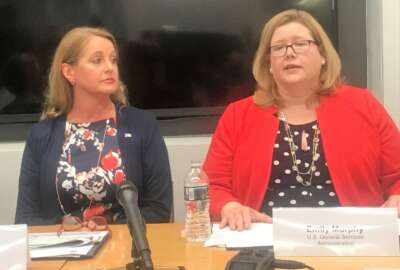
Cyber reskilled, but in my old job: A common refrain for program graduates
Margaret Weichert, the deputy director for management at the Office of Management and Budget, says she is deeply concerned about structural impediments to bring...
Best listening experience is on Chrome, Firefox or Safari. Subscribe to Federal Drive’s daily audio interviews on Apple Podcasts or PodcastOne.
Editor’s Note: The industry-government organization American Council for Technology and Industry Advisory Council, or ACT-IAC, rebounded nicely with the 2019 edition of its ImagineNation ELC conference.
With more than 1,000 attendees and dozens of sessions focused on all the typical hot topics in federal IT, the conference covered the range of discussions from thought provoking innovation that is happening across government, to the usual trite comments around “cyber is a team sport” or the oldie-but-goodie, “It’s not the technology, it’s the culture that needs to change.”
Several industry attendees told me they wish more government people attended, and others said they would liked to have seen a more non-IT discussion. But overall, the reaction is the 2019 version was much better all-around than the 2018 conference.
Here is part 1 of my takeaways from the 2019 edition of its ImagineNation ELC conference:
The cybersecurity reskilling initiative is, without a doubt, one of the highlights of the Trump administration’s management agenda.
The concept of training federal employees with new, in-demand skills addresses two big challenges every agency faces: The changing nature of work across the government and the inability to hire new employees quickly enough.
In fact, reskilling combined with the swift acceptance of robotics process automation are setting up the government to be much different place in the next decade. That is, if the administration can solve the systemic problems with the General Schedule system.
Related Stories

OPM to launch job rotation program for cyber reskilling academy graduates

How GSA is using data to drive better decisions

RPA more than a passing fad, just look at the data
“We have people who want new jobs. We have jobs, but we have a very old, well-intentioned code related to fairness in hiring, but it’s not agile and it’s not responsive to the needs of the 21st century,” Weichert said at the ImagineNation ELC conference. “I’m deeply concerned about structural impediments to bring agility to government.”
Weichert told me after her speech in a brief conversation that she realizes the GS system’s rigidness is a huge impediment to the governmentwide reskilling effort and wants to do something about it.
The administration will have a similar challenge if, or when, it gets its data scientist reskilling initiative off the ground, addressing another huge need across the government.
“Agility is built-in in the private sector. These companies know you can’t survive forever so they have to earn it every quarter,” she said. “It is critical for government to get where we need to be in the 21st century. I continue to ask for innovative thinking. Don’t stop because you know why it will not work, don’t stop giving us your ideas and how we can get to yes in the 21st century and turn good intentions into actual execution.”
One short-term approach to addressing the GS challenge is through a new cybersecurity rotational program for graduates of the academy. The job rotational program would last for nine months after the three-month academy.
Biggest obstacle to reskilling effort
But this will not solve the long-term inflexibility of the GS system.
The need to address the rigidity of the GS system is probably the biggest obstacle to the reskilling initiative being anything more than another good idea that another administration had but failed to deliver on because of a lack of internal fortitude.
The past two administrations are littered with these examples. The Obama administration wanted to decrease the “time-to-hire” for an employee. The Office Personnel Management under John Berry made real progress, that is until Berry left to become the ambassador to Australia and no one picked up the mantle to run with it.
The administration of President George W. Bush showed the power of shared services when it consolidated payroll providers, but the other efforts around human resources, financial management, grants and several others petered out for an assortment of reasons, including the lack of strong leadership that understood how to work with Congress.
Some may wonder if Weichert has enough time to begin making the GS system more agile given it’s an election year, there isn’t much appetite on Capitol Hill for good government initiatives, and since she may have only one year left in her role.
Additionally, others may wonder if Weichert had spent her year as both OMB DDM and acting OPM director fixing the GS system instead of pushing the ill-fated General Services Administration-OPM merger, if the reskilling initiative would’ve met the Trump administration’s transformation goals in a much more productive and impactful way.
Of course, there are big “P” politics in play for Weichert and the management agenda priorities, too, that went into her and others’ decisions.
Automation plus reskilling is a powerful combination
Let’s digress back to the agility discussion. One of the ways agencies can become more agile is through the use of automation.
GSA is one good agency example of applying automation and data to drive agility in how they meet their mission. GSA Administrator Emily Murphy said the Public Building Service is applying RPA to do bilateral modifications for more than 8,000 leases to add the provision that prohibits the use of ZTE, Huawei and other Chinese made telecommunications and video surveillance equipment.
“That means instead of leased contracting officers filling out forms and sending them out to everyone. We instead now have them press a button to send out the modified lease and then they can sign and ratify when it comes back,” Murphy said. “This is saving time and money.”
Latest Workforce News
Weichert said when she mentioned RPA to her staff at OMB more than two years ago, no one really knew much about it.
“Two years later how many RPA projects are there?” Weichert asking the audience at the conference with hundreds of hands going up in response. “That represents hours and hours of effectively wasted effort from people who had good intentions to serve customers who now are in better positions to serve customers and no longer have to do remedial menial tasks.”
The reason why agencies moved to RPA so quickly is the agility in the procurement system — which many would say is an oxymoron. But the fact is, vendors could add these services to the GSA schedule or other contracts and agencies could put out contracts to get the bots installed and see value in a relatively short amount of time.
This is not the case with the reskilling academy, which why Weichert, new OPM Director Dale Cabaniss and others should make fixing the GS system a top priority.
Because if Weichert wants her agile government that is powered by IT, people and data and one that builds trust, then it’s hard to see another path forward.
Copyright © 2025 Federal News Network. All rights reserved. This website is not intended for users located within the European Economic Area.
Jason Miller is executive editor of Federal News Network and directs news coverage on the people, policy and programs of the federal government.
Follow @jmillerWFED







